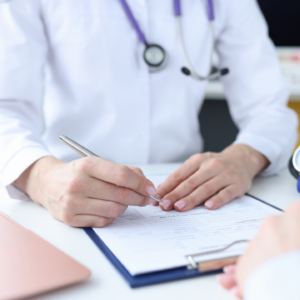Pregnant in France: Essential First Steps for Being Pregnant in France

So you’re late and not in the sense to a very important date, you think you might be pregnant. What do you do next? Who do you see? Do I need to immediately change my diet? There’s no need to panic, it’s not that complicated. You’re in the right place, here you’ll find the essential first steps for being pregnant in France, before you start calling friends and family. It’s very simple. Luckily, here in France, you’ll be accompanied closely between your sage femme (midwife), Ameli as well as the CAF.
Disclaimer: The content of this blog post is based on my own opinions, experiences, and research. I am not a licensed health professional, and the information provided here is not intended as medical advice. Any actions taken based on the information in this post are at your own risk.
For personalized advice or if you are considering making any significant changes to your health routine, I strongly recommend consulting with a qualified healthcare provider. If you experience any adverse effects or have health concerns, please seek immediate professional help.
What to do first
Take an at-home pregnancy test
One of the first things you’ll be asked by your médecin traitant or sage-femme is whether you took an at-home test or not. So before you even book your first appointment, you’ll need to buy an at-home pregnancy at your local pharmacie . There are several brands and types of tests, so choose whichever you feel is best. Keep it simple. I ended up going with a 2-pack of ClearBlue.
If you have any questions, do not hesitate to ask your pharmacist. They are there to also guide you and direct you in the right direction. It’s best to take the test (aka pee on the stick) in the morning because this is when your BetaHCG levels will be higher. This hormone usually shows up about 10 days after the egg has been fertilized.
If you have any doubts about anything, schedule a first appointment with your médecin traitant, where they’ll most likely prescribe you a blood test to check your levels more accurately.
Find your local PMI
You’ll want to do some research and figure out where your local PMI is at. This is the Centre de Protection Maternelle et Infantile. This center is an excellent resource if you’re not sure where to begin or where to go next and you feel completely lost on what’s next. The centers are free and open to anyone and everyone with children up to the age of 6. Your pregnancy can monitored here (suivi de grossesse), post-birth consultations and check-ups for your newborn. You can also sign up for group workshops where you can discuss your concerns, ask questions and receive advice from various professionals and other parents at the center.
To find the closest center near where you are here, you can look here.
Schedule your first doctor's appointment
Once you’ve peed on the stick and you’ve gotten your results, you’ll now want to schedule an appointment with your médecin, sage-femme or gynécologue. The appointment I scheduled with my doctor’s office was called retard de règle/début de grossesse. This appointment is to establish the fist steps to ensure your pregnancy. Here my doctor did an échographie (an ultrasound) to confirm the presence of an embryo.
You will also be given an ordonnance , prescription, for a blood test to check your Beta-HCG levels that should be done as soon as possible and then another one done within 4 days. This test needs to be done before noon, so plan on getting your blood drawn in the morning. You do not need to be fasting for this blood test, that will come later. You can also be given an ordonnance for a full blood panel, if not, you’ll be given at the end of your first trimester. My doctor gave me one due to my miscarriage the year before.
Tid-bit: Beta-HCG levels at the beginning of your pregnancy will double every 3-4 days, especially in the beginning. This will also help determine if the pregnancy is viable. In my case, when I was pregnant in 2023 and started spotting after the first ultrasound, my doctor prescribed the bloodwork to be repeated every 3-4 days to monitor my Beta-HCG levels. When I noticed that they weren’t going up, I knew that something was wrong.
Start taking your prenatal vitamins & folic acid
One thing you can start doing is taking your compléments alimentaires grossesse, prenatal vitamins. You do not need an ordonnance (prescription) from your doctor. You will need to ask about acide folique (folic acid) that is suggested to be taken when you suspect that you are pregnant. You will need an ordonnance for this.
Prenatal vitamins are not covered by the Assurance Maladie because they are not considered a medicine, but a supplement to the diet to help boost certain areas or types of development/growth.
There are several different options out there, you can ask your doctor or midwife which is best suited for you. I am currently taking Effik Gynéfam Supra Grossesse Capsules. These are what my doctor recommended taking back before my miscarriage and I kept taking them after knowing we were still trying for a baby. You can see a whole list of choices here.
What to expect during the course of your pregnancy
Here are some things you can expect to happen during the duration of your pregnancy:
- 7 medical visits (suivi de grossesse).
- Complementary tests & biological exams (ultrasounds, bloodwork, urine samples, etc…), some which are done monthly.
- 3 ultrasounds, one at the end of each trimester.
- Prenatal interview (l’entretien prénatal précoce) – an appointment different from the others, this is an informal meeting where no medical exam is taken place. This appointment is focused on discussing with the mother (or couple) about the projet de naissance (birth project), if there are any specific needs during or after the birth. This can be done with either your midwife or doctor. The appointment usually takes about 45 minutes.
- Prenatal check-up with a midwife or through the PMI – this appointment covers everything from your diet during pregnancy and the risks as well as discussing vaccinations and the steps to a safe and healthy pregnancy.
- 7 birthing classes with a midwife (that are completely covered by the SECU).
- A dental check-up that’s recommended after the 4th month of pregnancy up to 6 months after the birth of baby.
Did you know that dad can take advantage of a full check-up that’s covered 100% by the SECU? Just ask your healthcare provider.
Vocabulary
Here are some terms in French you’ll hear/see throughout your pregnancy.
- Accouchement– child birth, this refers to the whole act of giving birth; labor and delivery.
- Aménorrhée– lack of menstrual flow/period. You’ll see this word used in regards to the number of weeks after the first day of your missed period.
- Aminocentèse– Amniocentesis, in reference to the testing process for down syndrome. This is where amniotic fluid is removed for further testing for any abnormalities.
- Anémie– Anemia, which is having a low level of red blood cells that carry oxygen throughout your body. Some symptoms include fatigue, weakness and being short of breath.
- Clarté nucale– Nuchal translucency is the small/thick space at the nape of the neck of the embryo. This is measured in the first trimester and is used to detect any chromosomal abnormalities, in particular Down syndrome. Usually tested after 11 weeks.
- Constipation– constipation. Need I say anymore ? This is something that you need to be on the look out for, something I did not realize would happen to me (the only way I found out was by tracking my movements daily).
- Date prévue d’accouchement– due date. We”ll go into how due dates are determined in France on a later post.
- Déclaration de grossesse– pregnancy registration where your pregnancy, after the scan of the 1st trimester is registered with the CAF.
- Diabète Gestationnel– Gestational diabetes that is first detected during pregnancy, it works the same as typical diabetes. This form can affect the mother and the baby. A test is conducted between weeks 24 and 28 of pregnancy.
- Diagnostic Prénatal– Prenatal diagnosis, which is an exam used to detect a congenital condition before birth. This exam is only offered under certain circumstances: family history of genetic disease, late pregnancy, or suspicion of an abnormality during an ultrasound scan. The following can be used to detect any abnormalities: amniocentesis, fetal blood analysis, placenta biopsy, etc.
- Echographie– ultrasound, which can be done internally as well as externally.
- Fausse couche– miscarriage.
- Fuites urinaire– bladder weakness.
- Grossesse extra-utérine– Ectopic pregnancy, where a fertilized egg implants and grows outside the main uterine cavity, mainly in the fallopian tube.
- Haptonomie– Haptonomy, which is a method created by Dutch doctor Frans Veldman, enabling the future parents to communicate with their child during pregnancy. This is done through emotional contact with the baby, it also helps the mother to cope better with the pain of childbirth. Usually started around the 4th month of pregnancy.
- Hémorroïdes– Hemorrhoids, an unfortunate but not uncommon occurence during pregnancy. These are swollen veins in or around the anus and can be quite painful. You’ll want to talk to your healthcare provider if you have any questions or concerns. There are treatments you can take that will help if you do find that you have hemorrhoids. All I can say is prunes.
- Hypertension– Hypertension or high blood pressure that usually shows up after 20 weeks pregnant and typically goes away after birth. This is anything greater or equal to 140/90 (“normal” BP is 120/80).
- Pelvimétrie– Pelvimetry, where the diameter of the pelvis is measured, typically done when baby is presenting breeched to determine if a vaginal delivery is possible.
- Périnée– Perineum, the thin layer of skin and muscle between the vaginal opening and the anus. Women typically tear here during labor and delivery.
- Poche des eaux– Amniotic sac, which in it contains fluids and the baby that sit inside the uterus. It is a water-like substance that contains various hormones, antibodies and other fluids to help keep baby healthy and protected in utero.
- Préeclampsie– Preeclampsia, a serious blood pressure condition that can appear any time after 20 weeks of pregnancy. Preeclampsia side effects include hypertension, proteinuria, as well as kidney and liver issues. This needs to be monitored closely and right away to avoid any damage.
- Rétention d’eau– Edema, fluid build-up in the extremities, such as feet, legs, and ankles. Typically shows up at any point, but most noticeably starting around the 5th month of pregnancy and going through the 3rd trimester. Best thing to do is kick up your feet or wear compression socks.
- Siège– Breech, when the baby is presenting bum or feet-first in the uterus. Typically baby wants to present head-first after 36 weeks.
- Trisomie 21- Down syndrome, the genetic condition where there are 47 chromosomes instead of 46.
- Toxoplasmose– Toxoplasmosis, an infection of the parasite toxoplasma gondii. Pregnant women can get this either through contaminated food (mainly meats) or cat poop.
- Vergetures– stretch marks.


You May Also Like

Pregnant in France: Declaring your pregnancy in France
2 October 2024
Pregnant in France: What to expect at your first trimester appointment in France
18 September 2024